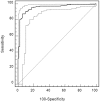Urinary proteomic biomarkers for diagnosis and risk stratification of autosomal dominant polycystic kidney disease: a multicentric study
- PMID: 23326375
- PMCID: PMC3542378
- DOI: 10.1371/journal.pone.0053016
Urinary proteomic biomarkers for diagnosis and risk stratification of autosomal dominant polycystic kidney disease: a multicentric study
Erratum in
- PLoS One. 2013;8(8). doi:10.1371/annotation/9281c713-d253-4a1a-8255-92e691e77a24
Abstract
Treatment options for autosomal dominant polycystic kidney disease (ADPKD) will likely become available in the near future, hence reliable diagnostic and prognostic biomarkers for the disease are strongly needed. Here, we aimed to define urinary proteomic patterns in ADPKD patients, which aid diagnosis and risk stratification. By capillary electrophoresis online coupled to mass spectrometry (CE-MS), we compared the urinary peptidome of 41 ADPKD patients to 189 healthy controls and identified 657 peptides with significantly altered excretion, of which 209 could be sequenced using tandem mass spectrometry. A support-vector-machine based diagnostic biomarker model based on the 142 most consistent peptide markers achieved a diagnostic sensitivity of 84.5% and specificity of 94.2% in an independent validation cohort, consisting of 251 ADPKD patients from five different centers and 86 healthy controls. The proteomic alterations in ADPKD included, but were not limited to markers previously associated with acute kidney injury (AKI). The diagnostic biomarker model was highly specific for ADPKD when tested in a cohort consisting of 481 patients with a variety of renal and extrarenal diseases, including AKI. Similar to ultrasound, sensitivity and specificity of the diagnostic score depended on patient age and genotype. We were furthermore able to identify biomarkers for disease severity and progression. A proteomic severity score was developed to predict height adjusted total kidney volume (htTKV) based on proteomic analysis of 134 ADPKD patients and showed a correlation of r = 0.415 (p<0.0001) with htTKV in an independent validation cohort consisting of 158 ADPKD patients. In conclusion, the performance of peptidomic biomarker scores is superior to any other biochemical markers of ADPKD and the proteomic biomarker patterns are a promising tool for prognostic evaluation of ADPKD.
Conflict of interest statement
Figures




Similar articles
-
Urine peptidome analysis predicts risk of end-stage renal disease and reveals proteolytic pathways involved in autosomal dominant polycystic kidney disease progression.Nephrol Dial Transplant. 2017 Mar 1;32(3):487-497. doi: 10.1093/ndt/gfw243. Nephrol Dial Transplant. 2017. PMID: 27382111
-
Rapid Progression of Autosomal Dominant Polycystic Kidney Disease: Urinary Biomarkers as Predictors.Am J Nephrol. 2019;50(5):375-385. doi: 10.1159/000502999. Epub 2019 Oct 10. Am J Nephrol. 2019. PMID: 31600749 Free PMC article.
-
Identification of a unique urinary biomarker profile in patients with autosomal dominant polycystic kidney disease.Kidney Int. 2009 Jul;76(1):89-96. doi: 10.1038/ki.2009.93. Epub 2009 Apr 1. Kidney Int. 2009. PMID: 19340089
-
Insights into autosomal dominant polycystic kidney disease by quantitative mass spectrometry-based proteomics.Cell Tissue Res. 2017 Jul;369(1):41-51. doi: 10.1007/s00441-017-2617-9. Epub 2017 Apr 21. Cell Tissue Res. 2017. PMID: 28432464 Review.
-
Clinical and laboratory markers of autosomal dominant polycystic kidney disease (ADPKD) progression: an overview.Minerva Med. 2015 Feb;106(1):53-64. Epub 2014 Oct 10. Minerva Med. 2015. PMID: 25300895 Review.
Cited by
-
Potential urine proteomics biomarkers for primary nephrotic syndrome.Clin Proteomics. 2017 May 16;14:18. doi: 10.1186/s12014-017-9153-1. eCollection 2017. Clin Proteomics. 2017. PMID: 28522940 Free PMC article.
-
Urinary proteomics using capillary electrophoresis coupled to mass spectrometry for diagnosis and prognosis in kidney diseases.Curr Opin Nephrol Hypertens. 2016 Nov;25(6):494-501. doi: 10.1097/MNH.0000000000000278. Curr Opin Nephrol Hypertens. 2016. PMID: 27584928 Free PMC article. Review.
-
Biomarkers of Kidney Disease Progression in ADPKD.Kidney Int Rep. 2024 Jul 14;9(10):2860-2882. doi: 10.1016/j.ekir.2024.07.012. eCollection 2024 Oct. Kidney Int Rep. 2024. PMID: 39435347 Free PMC article. Review.
-
Urinary proteomics in chronic kidney disease: diagnosis and risk of progression beyond albuminuria.Clin Proteomics. 2015 Aug 7;12(1):21. doi: 10.1186/s12014-015-9092-7. eCollection 2015. Clin Proteomics. 2015. PMID: 26257595 Free PMC article.
-
Predictors of progression in autosomal dominant and autosomal recessive polycystic kidney disease.Pediatr Nephrol. 2021 Sep;36(9):2639-2658. doi: 10.1007/s00467-020-04869-w. Epub 2021 Jan 21. Pediatr Nephrol. 2021. PMID: 33474686 Free PMC article. Review.
References
-
- Dalgaard OZ (1957) Bilateral polycystic disease of the kidneys; a follow-up of two hundred and eighty-four patients and their families. Acta Med Scand (Suppl 328) 1–255. - PubMed
-
- Iglesias CG, Torres VE, Offord KP, Holley KE, Beard CM, et al. (1983) Epidemiology of adult polycystic kidney disease, Olmsted County, Minnesota: 1935–1980. Am J Kidney Dis 2: 630–639. - PubMed
-
- Hateboer N, v Dijk MA, Bogdanova N, Coto E, Saggar-Malik AK, et al. (1999) Comparison of phenotypes of polycystic kidney disease types 1 and 2. European PKD1-PKD2 Study Group. Lancet 353: 103–107. - PubMed
-
- Chapman AB, Johnson AM, Gabow PA, Schrier RW (1994) Overt proteinuria and microalbuminuria in autosomal dominant polycystic kidney disease. J Am Soc Nephrol 5: 1349–1354. - PubMed
Publication types
MeSH terms
Substances
Grants and funding
LinkOut - more resources
Full Text Sources
Other Literature Sources
Medical

